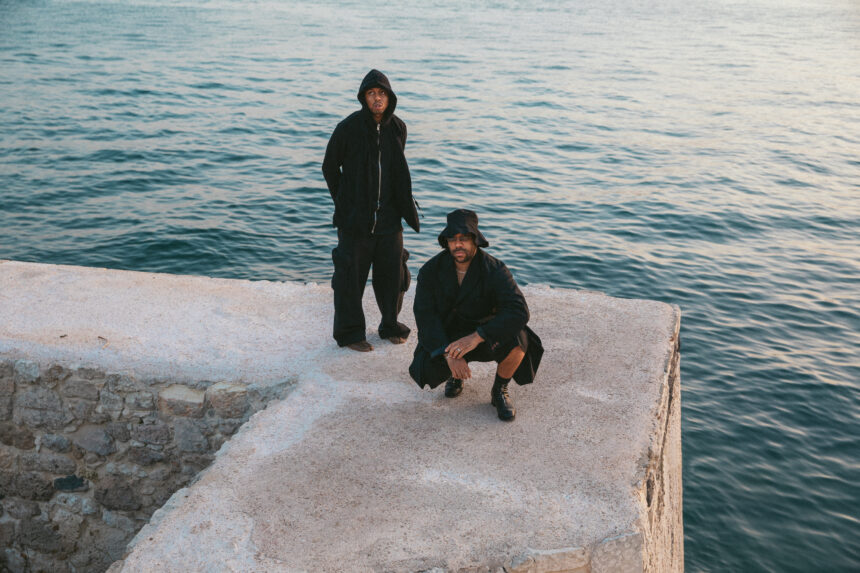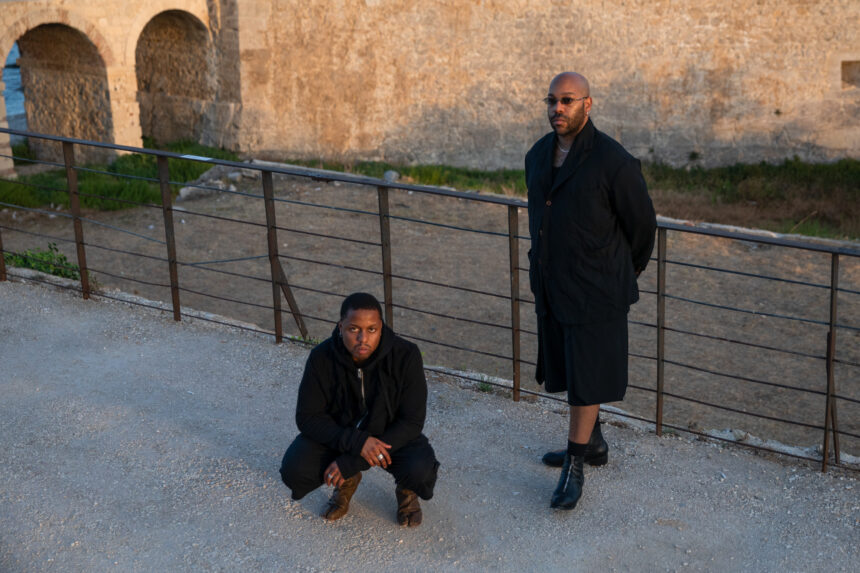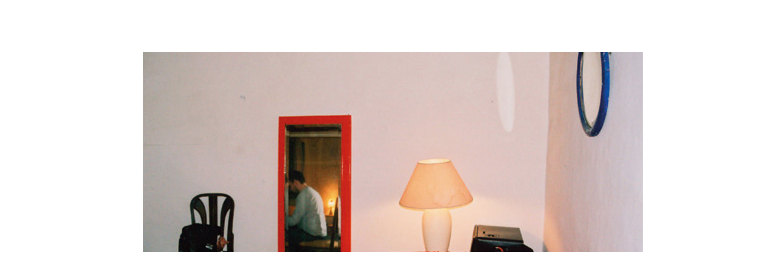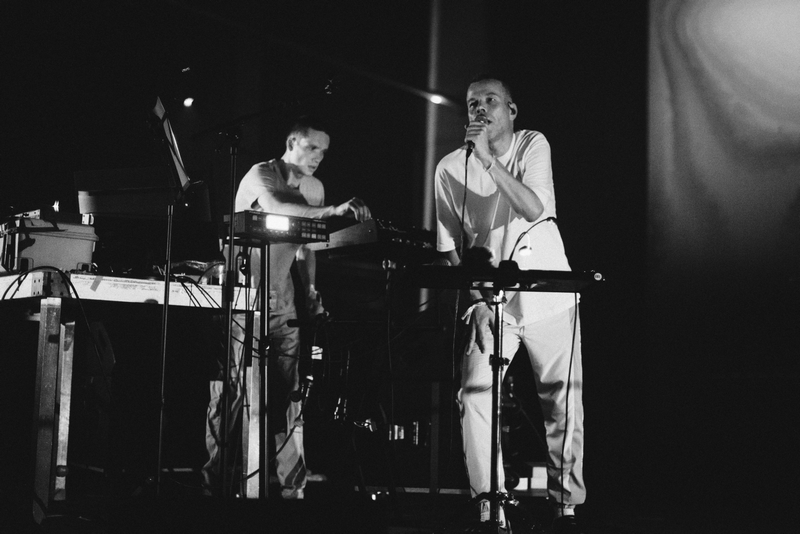Space Afrika – “Experience is at the root of everything that we produce” (Interview)

By Ivna Franic, photos by Glauco Canalis
The concert season in Copenhagen is gearing up to be the most exciting it’s been in ages, and Space Afrika makes for one of its high points. Their upcoming show was as good an excuse as any to catch up with the duo made up of two Joshuas – Reid and Inyang. With strong releases such as their 2021 LP Honest Labour or last year’s collaborative album with Rainy Miller, A Grisaille Wedding, under their belt, Space Afrika have come to be one of the most interesting acts on the experimental edges of electronic music. Originally hailing from Manchester, the duo is now split between there and Berlin. Joshua Reid connected first, and while we waited for Inyang to resolve the technical difficulties that inevitably come with online interviews, we started chatting about different music scenes.
Passive/Aggressive: You’ve been living in Berlin for a while now. How would you compare Manchester and Berlin when it comes to music scenes and some general creative stimulus?
Joshua Reid: “I would say that they’re different in some ways and similar in others. Obviously, it was different growing up in Manchester compared to living in Berlin, the latter being a capital city. You just see much more funding, and much more availability to move into different directions there. I guess one of the special things about Manchester is that it has a very strict legacy of hard work and kind of like doing it in your own way, in a kind of like DIY fashion. I mean, Berlin has its history as well in terms of predecessors, but I guess they’ve got some slightly different energies in terms of accessibility, size, and also just opportunities for actually doing projects. I mean also, if you look at it from a perspective of clubs and studios, there’s just a lot more of them in Berlin compared to Manchester, of course. There’s a lot more infrastructure in place to support different projects that you might do, performances for example, more of a push towards creative arts.”
P/A: A few years ago, when I was writing a feature about the Copenhagen music scene from an international perspective, all the people from the UK said that they missed this multicultural element, that here it wasn’t so mixed in terms of genres and communities.
JR: “Yeah, that would make sense, I think. In terms of musical history, it’s super multicultural in the UK from the top to the bottom and so there’s a lot more of – I don’t like using the word “scenes” – but there’s a lot more cross-mixing between different genres, I would say. It’s not as standardized, like, that’s one scene, that’s one genre… Maybe that’s the case in other countries, but in the UK it’s a lot more of a mesh of mixtures of different types of collaborations happening.”
P/A: I saw you guys play live at the Intonal festival in Malmö two years ago. I really liked that show. What I thought was interesting was that it felt like a thing of its own, like you weren’t just performing tracks off the record in a specific order. I also liked how you used visuals as an important part of building the atmosphere. What are you preparing for this show in Copenhagen? Who makes the visuals and do you change them from show to show, or tour to tour?
Joshua Inyang: “Well, firstly thanks for the kind words. I remember that show, that was really fun. At the moment, we are extremely open to what we’re performing and the music that we’re playing. To be completely honest with you, at this point, me and Josh couldn’t tell you what we’re going to play. [laughs] From the end of last year, we’ve been creating a lot of ideas and individual sounds that one day may or may not enter a project, you know, music and ideas for other artists and stuff. Before every show, at least for the last couple of shows, we’ve kind of just gone off the energy that we’re feeling and are inspired by at the moment. Being in two different cities, we kind of have this freshness and surprise that we approach the shows with, so we’ll most likely develop that on the day.
There’s a pool of music that we’ve been working around, having some time to sit back and produce, maybe towards new records and stuff. So for Copenhagen, we can expect a very fresh and unanticipated show of definitely new music, maybe with one or two pieces that have been released beforehand, and also the same for the visuals. I think, depending on the countries that we’re playing, we’ll maybe come up with a live set with new visuals every few sets of shows. If we haven’t played somewhere before, maybe we’ll reuse some footage. But entering the new year and a new live set, we’ve got a relatively upgraded set of visuals and to date it’s been me and Josh who created the visuals. At times we work with a close friend and collaborator Tibyan Sanoh, who’s also from Manchester, a filmmaker and director. But at the moment we’ve been predominantly producing our own visual work.”
“There are so many factors, there are so many wars, individual experiences, etc., that we’re experiencing day-to-day… It’s just always going to be at the root of everything that we produce.”
Joshua Inyang
P/A: You mentioned that you change materials from city to city. I remember in Malmö there was a moment in the visuals that showed a scene of police brutality and the crowd immediately reacted to it. Maybe you wouldn’t instinctively think of that as material that’s going to be so relatable in Sweden, but the audience seemed to have really connected to the issue of police violence.
JI: “I think there are a lot of issues and themes that pour into the music consciously and unconsciously. With the visuals mostly being based on real-life, everyday things that we experience, and also from our viewpoint – like a lot of insight on the black experience and the black experience in the UK – there’s a lot of things that whether black, white, or any other race, that we share in a lot of conflicts and political situations that we all encounter. It’s special when things add up and they resonate with people at particular times. I think it’s always nice and important to have some sort of message in the music we create.”
P/A: Speaking of the importance of the message. Nowadays, a lot of experimental releases come with long promo texts about some great political message in their work and then you listen to the – and it doesn’t really come across. How do you make politically conscious music without necessarily using words? What is it in your music that you see as political?
JI: “I think it’s just that the majority of the work that we produce is a response to experience, a response to something we’ve seen or we’ve lived recently, and that seems to be the main driver for everything we produce. It can be political or non-political – sometimes it’s intentional, maybe a lot of the time it isn’t, but it feels like there is always importance or a message in what we do. Sometimes we’re able to convey that directly, and sometimes we’ll respond to something in real time. For example, in 2020, the have you been through what I’ve been through? mixtape had two main influences – one global and the other extremely personal that just drove us directly to produce in that manner. At the heart of it, it’s always a response, and I think as young adults in the UK or Europe, with everything that’s going on with the world, it’s very hard to not have something to respond to. There are so many factors, there are so many wars, individual experiences, etc., that we’re experiencing day-to-day… It’s just always going to be at the root of everything that we produce.”
P/A: To circle back to the visual aspect – I feel like it’s really important to the project, not only in how you use it in live shows but also for music videos and album covers. How do you approach the relationship between different media?
JR: “I mean, the important thing is to try to find the best avenue to convey the message, whether it’s sound or visual or speech or poetry, it’s all one and the same. I guess the visuals play as an extension of the sound but they also reinforce the sound in a way, to kind of create a textural image as a backdrop towards the theme. So I guess one thing that is quite interesting, which you mentioned before about the different sites, is that the visuals play a role in terms of where we’re playing, in terms of them being site-specific, relating to the architecture of the room, and this kind of stuff. In responding to experiences, it becomes almost the same – you may be trying to tell the message through the sound, but then you also have these visual images that come into your head and so you realize that some of the visuals are just real life, just getting by, or just day-to-day experiences, and so even though it might be specific to words, it does seem to translate across different territories, which is a positive message.
It’s also a way to try and challenge yourself to see something differently so that you don’t get stuck in the same situations again, where you try to overcome them by laying it all out on the table, seeing it, experiencing it from a different kind of medium so that you’re not necessarily seeing it as a kind of a single philosophy. With the visuals, I think it’s kind of like a way of self-realization as it’s happening in real-time, and then it ends up like a feedback loop with the sound as well.”
JI: “That’s exactly what I was going to say next. One of the most basic elements of what we do is that sometimes the music incorporates a lot of field recordings, the real-life element is becoming a musical element, and we think sometimes it’s quite nice to have the actual backdrop of where we’ve got that inspiration or a particular sound from, so you can see it as well as hear it and feel it as a whole.”

P/A: That’s the next thing I wanted to ask you. You include a lot of these field recordings from surroundings both in the music and the visuals. How do you choose what to record and do you immediately think about what you might use some of those recordings for?
JI:” It happens quite naturally. There’s not so much of a thought process, I guess. At times, we may end up on a run where we’re just exploring the internet or we’ve watched something and it might spark an idea. Then you dig more into that particular scene and in the process of doing that, you just come across interesting moments, sounds, and things that just pop out to you and they might immediately spark an idea as a sample to use at some point. We may even use them completely raw in the actual production or the presentation as layers or almost like bridges between the music. It seems quite instinctive.”
“Whether it’s sound, photography, visuals, or whatever it may be, everybody should try and get their message out through the best medium possible.”
Joshua Reid
P/A: It seems to be an important feature – this kind of backdrop of contemporary life – because, in real life, there is always something in the background. Why do you find it important to include it in the music and visuals? Do you see the broadly defined ambient music or experimental music not simply as some sort of backdrop to shut out to but also as a means of reflection, of holding a mirror to the contemporary urban environment?
JR: “I think it’s also that the need to create can go further than just sounds. From the start of the project, there was always a visual element to the artwork or the releases. Josh and I have been exploring visual art since a long time ago, it’s just that now has felt probably the most necessary time to start releasing it in a format that is much more structured.
The inspiration can come from listening but it also comes from watching films, watching short documentaries, or just taking in the visual outlook of the surroundings that you’re in, so I think in terms of genres like ambient and experimental, those genres themselves can be applied not just to music but to other mediums within arts as well. Sometimes you watch a film and it’s an experimental film but also that film can be super ambient, it can slow you down, it can take you back… Hopefully, when people watch the visuals, it could be like a scene of somebody just walking around at night, and that feeling in itself can feel ambient without sounds. It could just be the sound of cars or the lights, or you’re driving back from a rave or whatever, and you’re just sitting in the back seat watching street lights go past… I just think it’s all part of the same package and so whatever you need to express yourself, you should have as many tools available to yourself to express that feeling and not be confined to one specific medium to do it. Whether it’s sound, photography, visuals, or whatever it may be, everybody should try and get their message out through the best medium possible.”
P/A: When it comes to musical expression in particular, your music usually gets lumped into some kind of dub techno/ambient/experimental drawer, but both on your records and your radio mixes, there is a much wider range of styles. Do you feel like you can channel the vibe of different genres via your own means?
JI: “It’s nice to hear that because I do think our earlier works were rooted in dub, dub techno, and ambient, but I’d like to think, especially over the last few years – and progressively – that there is such a wider spectrum of sound that we incorporate and that we’re inspired by. Every few shows or every other show is different from the last in its own way. I do think being confined to strict genres is a bit limiting for what we do. I understand that people try to make context or make it easier to translate something across interviews or press, for example, but I do think we have a wider spectrum of music that we incorporate – experimental at the heart but that flows over from trip-hop definitely, folk, noise music, even gospel and including some classical elements… Everything we’ve done more recently, we’ve done with having an interest in moving a lot more into film and visual work. There are so many elements that we work towards now – I’m not sure how visible all of that is, but some of them are much further away than being limited to just ambient than a lot of people may take in, and I think over time that’s something that people are coming to understand and perceive from our work.”
“We love the conception because quite often at the beginning of any work or idea, that’s the purest form of it.”
Joshua Inyang
P/A: One of your recent radio mixes featured a lot of folk music and it just felt like that made perfect sense, even though it’s musically different from your releases. Your radio shows feel similar to the live performances in that they always sound like more than just a collection of songs, they’re sets of their own. Also, you released a mixtape a few years ago. Is there space for mixtapes in the – again, loosely defined – ambient music context? Because that would be something that would be fun to see more of!
JI: “Yeah, definitely! I mean, there’s space for everything. I think artists have a duty to experiment and to present works in different ways, whether that’s an album, a mixtape, or even just two songs online. I don’t think that a genre or any particular theme is limited to being put out in a certain way. One thing I do appreciate is that artists take a significant level of care in the way that they present their work and we want to tell a story a lot of the time, but sometimes we just need to have fun and let loose. Sometimes in the process of making these grander, more thought-through works, there’s so much music in the pipeline or ideas that just sat there… And sometimes the more simple ideas are as beautiful as a six-month journey to produce this perfect record. For us – and this reflects also on the live shows and the visual element – we really love the rawness of everything. We love the conception because quite often at the beginning of any work or idea, that’s the purest form of it. So, yeah, there definitely should be room for mixtapes. We should all feel a lot freer in just releasing things when it feels right or when it feels good, we definitely shouldn’t be limited to the way that we format or present work. I do agree that mixtapes or looser ways of dropping things can be more exciting and something that might be more empowering for artists today – if we all take a lighter approach to expressing ourselves.”
JR: “I would just add – in terms of the live shows in themselves, in some respect they are like mixtapes because it’s [an exchange] from us directly to the audience, there’s nothing else in it, there’s no one else involved in it, it’s just from the source straight to the performance. It is the rawest kind of presentation of anything and I think that’s why it’s so much fun. And it’s so different depending on where we play because it is the most pure expression that you can have from the work that you’ve done to the audience seeing it. So that’s where a lot of the fun and the magic lies, and the creativity, and the ideas. One of the benefits of playing live is that we don’t have to be in a strict format where it’s like – do an album, tour an album, and then do another album and tour, and then tour another album – it’s the time to make a lot of creativity and change ideas and have a lot of fun and just totally express yourself. That’s the key. We go to shows ourselves and we hear that in other people’s music and that’s where a lot of the enjoyment comes from.”
P/A: You put a collaborative album out with Rainy Miller last year, you also played some shows with Caterina Barbieri, and actually, your records often feature guest spots. Are collaborations an important part of your creative process and do you feel like there is a general trend towards more collaborations and collectivity in the music scene?
JI: “For us there definitely is. Everything is a matter of timing and what feels right at a certain moment and there are particular movements – whether it’s in the UK, Manchester, or Europe, Berlin, wherever you are. You meet people on tour, you have these friendships, and they lead to new ideas and collaborations that just open up a whole new world of concepts and production. It’s a beautiful thing when it can happen and we definitely encourage more collaboration. It’s a great route to producing new music, new sounds, new context… Also, it’s quite freeing as an artist to just let go of things or of your own approach to producing the final work. Being able to pass something over to someone and give them control is both freeing and informing – it brings so many new opportunities and things that other artists have the capability to do that we may not be able to. So it’s quite an exciting ground to work on.”
“This year is definitely a period of development for us.”
Joshua Inyang
P/A: Speaking of the exciting ground to work on – what are you working on at the moment?
JI: “Not to say too much, but at the moment we’re back in the lab, working on new music and sounds. Right now, at the forefront of everything seems to be a lot of focus on film and score work. We have a lot of interesting projects and partnerships that we’re working towards. We’ve been working with Parisian filmmaker Valentin Noujaïm and we’ve just recently released two films with him that we produced the score for. At the moment, we’re very much focused on film media and artwork, actually. Music always is in line with that and in tandem, and we’re very much back in the experimental stage of producing works, collaborating, and just trying to find new avenues and formats for how we can present ourselves and also develop and grow. This year is definitely a period of development for us.”
P/A: You mention different modes of expression quite a lot. Do you see Space Afrika as more than a music project?
JI: A thousand percent yes. It’s been a natural projection for us for some time and now it’s coming to fruition. It’s something that feels extremely fulfilling, it feels right. There’s also so much potential for us as the band Space Afrika, as individuals – I don’t think we ever want to limit what kind of work there is to create. I would like to think of us as artists in the purest sense, with just an open field of possibilities with what we’re able to create.
Space Afrika will have their Copenhagen live debut tonight (March 23rd) at Unearth’s event at Basement.


